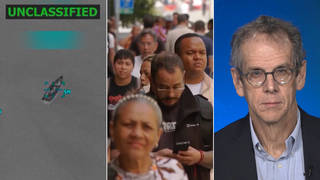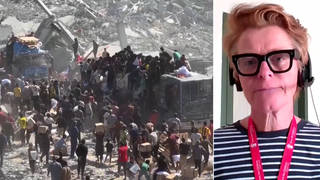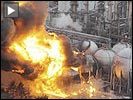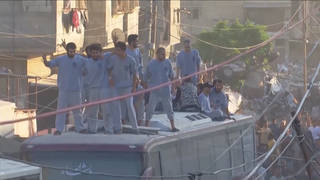
Topics
Guests
- Philip Whiteinternational liaison officer at the Citizens’ Nuclear Information Center in Tokyo, Japan.
- Ira Helfandboard member for Physicians for Social Responsibility. He is an expert on nuclear power, nuclear waste and radiation exposure.
The Japanese nuclear crisis worsens as Japanese authorities race to cool the overheating reactors at the Fukushima Daiichi nuclear power station. Earlier today, Japan raised the nuclear alert level at the crippled plant from a four to a five, on par with Three Mile Island. This decision has shocked many nuclear experts. “Our experts think that it’s a level 6.5 already, and it’s on the way to a seven, which was Chernobyl,” says Philip White of the Citizens’ Nuclear Information Center in Tokyo. We also speak with Dr. Ira Helfand of Physicians for Social Responsibility about the long-term health effects from radiation exposure from Fukushima. [includes rush transcript]
Transcript
JUAN GONZALEZ: The Japanese nuclear crisis continues to worsen as authorities race to find a way to cool the overheating reactors at the Fukushima Daiichi plant. Earlier today, Japan raised the nuclear alert level at the crippled plant from a four to a five, which is on par with Three Mile Island. Japan’s prime minister, Naoto Kan, described the situation as, quote, “still very grave.”
Japan is continuing to dump water on the reactors, while attempting to fix a power cable that could help restart the water pumps needed to cool the overheating nuclear fuel rods. But Gregory Jaczko, the chair of the U.S. Nuclear Regulatory Commission, said Thursday that it could take weeks for the crisis to be brought under control.
Meanwhile, the number of dead and missing from last week’s devastating earthquake and tsunami has now topped 16,000. It is the deadliest natural disaster to hit Japan in nearly a century.
Twenty-two hundred emergency shelters are operating in the disaster zone, but many are running out of food, fuel, water and medicine. The organization Save the Children estimates 100,000 children have been left homeless.
To talk more about the crisis in Japan, we’re joined by Philip White of the Citizens’ Nuclear Information Center in Tokyo, Japan. Also with us is Dr. Ira Helfand of Physicians for Social Responsibility and longtime nuclear critic Ralph Nader, author of the recent book Only the Super-Rich Can Save Us!
I want to begin with Philip White in Tokyo. Your sense of this latest announcement by the Japanese government that it’s raising the level of the emergency and what you’re seeing from Tokyo?
PHILIP WHITE: I think it’s a good indication of how they are underestimating the seriousness of the problem. Our experts think that it’s a level 6.5 already, and it’s on the way to a seven, which was Chernobyl. It’s actually — we were very shocked that they only called it a five.
JUAN GONZALEZ: And why do you — what makes you think that the level is still being so grossly underestimated?
PHILIP WHITE: Well, you have — so much radiation is already out — radioactivity is already out there. You have spent fuel pools in at least two of the reactors that are burning and exploding and things like that. You’ve got a hole in another reactor — well, in the containment vessel. You’ve got six reactors lined up there, ready to go off any minute. And they think that’s a five. I’m not quite sure what they’re thinking about, really.
JUAN GONZALEZ: Well, we’ve begun to get some of the actual levels of radiation that have been measured. The helicopters, for instance, that flew over some of the reactors yesterday, trying to dump water on them, measured, supposedly, according to the Japanese government, at levels of 300 meters above the reactors, about four millisieverts of radiation per hour, and then at 100 meters, which is where they descended to, 87 millisieverts per hour. Could you talk to — tell us what that means in layman’s terms, for those who don’t know the levels of radiation measurement?
PHILIP WHITE: Millisieverts, so that’s a thousand of those makes up one sievert. And one sievert is well and truly into the high dose of radiation, and you’re getting acute — you’re getting acute radiation symptoms well below that. When you’re counting millisieverts, you’ve got to remember, this is per hour, so people who are actually there for any length of time, you multiply that figure by the number of hours they’re there. So, people who are actually on the plant — in the plant, although they’ll have protective clothing, they’re getting massive doses of radiation by now.
People off the site, we’ve seen figures in — around 170 millisieverts per hour at 30 — sorry, 170 microsieverts per hour at about 30 kilometers. Now, microsieverts, it’s a much smaller figure, but those people are potentially there for quite a long time. And if they were outside, which hopefully they’re not, they would be getting the average yearly dose in about a day or less, or maybe 10 hours or something like that. So, just think of that. In one day, you can get your average [yearly] dose of radiation if you go out 30 kilometers from this site.
JUAN GONZALEZ: We’re also joined by Ira Helfand of Physicians for Social Responsibility. Your assessment of the — talk about the dangers of the radiation in the exclusion zone to the workers and the potential for other areas outside the exclusion zone.
IRA HELFAND: Yeah, I mean, there are basically two distinct dangers that we’re faced with a reactor accident of this sort. One is the levels of very high radiation, which are primarily confined to the area right around the plant, at least at this point. And these are doses which, if you get up to a full sievert, will cause, as Philip was just explaining, radiation sickness. This is primarily a concern for people working in the plant, the 180-some-odd workers who have stayed behind there to try to bring this situation under control. If there was a much larger release, this conceivably could be a problem further out, but hopefully would not go out beyond the evacuation zone.
I think the danger, though, that we need to focus on, because it’s the one that affects the largest numbers of people, is the danger posed by low-level radiation and the possibility of cancer and other chronic illnesses being caused down the road from this episode. The radioactive material coming out of the plant is made up of about 200 different radioactive isotopes, and particles of these radioactive materials can travel great distances with the wind if they are dispersed into the air. We’re picking up radiation as — you know, elevated levels of radiation in Tokyo and in other places at some remove. At this point, those levels are still quite low. And while it is important to emphasize that there is no safe level of radiation — any radiation exposure increases your risk of cancer — the levels that people are being exposed to at this point remain quite low, if you get away from the plant itself, and will have very low health effects.
If there’s a larger release from this plant — and the situation there is still completely out of control — that could change very dramatically, and we could end up with a situation, as occurred at Chernobyl, where significant amounts of these radioactive isotopes get deposited downwind, contaminating populations, exposing them to an increased risk of cancer. And the best estimate that I’ve seen is that there will be approximately 250,000 excess cancer deaths, ultimately, as a result of the Chernobyl accident. We could have the same kind of wide deposition of radioactive materials if there’s a much larger release than has occurred so far.
In addition, large areas of ground can become so contaminated that people can’t use these areas for extended periods of time. And again, the Chernobyl experience, there were areas up to 100 miles downwind from the plant that had to be evacuated and which remain unsafe for human use today.
So, these two distinct differences — these two distinct dangers: the high doses of radiation affecting primarily people right around the plant at this point and then the potential for a fairly broad distribution of low-level radiation, which could be quite, quite destructive from a public health point of view.
JUAN GONZALEZ: And your sense of the differences that have emerged between the U.S. government’s assessment of the problem and the Japanese government at this stage?
IRA HELFAND: Well, I think it’s very hard to figure out what’s going on for sure. And I think both the U.S. and the Japanese governments are working somewhat in the dark here. And so, it’s kind of hard to know whose assessment is right. But I think that what you’re seeing on the part of the Japanese is that — one might perhaps wish to evacuate up to 50 miles, as the U.S. government has suggested should be done. I’m not sure how you do that in a situation where the area has been devastated by an earthquake and a tsunami.
I think, from my point of view, the most important aspect of the U.S. government recommendation of a 50-mile evacuation zone applies not just to the situation here in Japan right now, but to potential future situations in the United States. The primary danger to American citizens at the moment is not from radiation emanating from the plant in Japan; it’s the potential future release of radiation if we have an accident like this in the United States. And, for example, the nuclear plant in the U.S. which has been said to be most vulnerable to earthquake activity is not, as I had expected, in California; it’s Indian Point, 27 miles north of New York City. If there were to be the kind of release at Indian Point that we are seeing now at Fukushima, a 50-mile evacuation zone involves the entire New York metropolitan area. And I’m not sure quite how we would evacuate the 20 million people who live in that metropolitan area or where we would put them.
JUAN GONZALEZ: Well, we’re going to discuss precisely that when we come back from break. We’re talking with Philip White from the Citizens’ Nuclear Information Center in Tokyo and Ira Helfand from Physicians for Social Responsibility. And we’re also going to discuss this with Ralph Nader. We’ll be back in a moment.
[break]
JUAN GONZALEZ: We’re discussing the continuing nuclear crisis in Japan, and we’re joined by Philip White from the Citizens’ Nuclear Information Center in Tokyo, Dr. Ira Helfand from Physicians for Social Responsibility, and Ralph Nader joins us from Washington, longtime consumer advocate, corporate critic and former presidential candidate. His latest book is Only the Super-Rich Can Save Us!
Welcome to Democracy Now!, Ralph.
RALPH NADER: Thank you, Juan.
JUAN GONZALEZ: Your assessment not only what’s happening in Japan, but what the impact will be here in the United States, and especially with the Obama administration and Congress trying to move forward with a renaissance of development of nuclear plants here in the United States?
RALPH NADER: The Japanese disaster has ended whatever nuclear renaissance is being considered here in the United States. The problem is that people have got to get more involved, because the government and the industry will defend nuclear power in the United States to the last mutation. They are representing a closed, monetized mind that does not have options for revision, which true science should provide for. Secretary Chu, Energy Secretary, has refused for two years to meet with the leading critics of nuclear power, such as the Union of Concerned Scientists, Friends of the Earth and other groups. He has met with nuclear business interests regularly, and he has written articles touting nuclear power.
What we’re seeing here is 110 or so operating nuclear plants in the United States, many of them aging, many of them infected with corrosion, faulty pipes, leaky pumps and combustible materials. These have been documented by data from the Nuclear Regulatory Commission assembled by the Union of Concerned Scientists. Indian Point, for example, is a plant that presents undue risks, in the opinion of the Union of Concerned Scientists, to millions of people in the New York City greater area. And it is unevacuable if there’s an accident. You’re never going to evacuate a population of millions of people, whether it’s around San Onofre or Diablo Canyon in Southern California or Indian Point or Davis-Besse near Toledo and Detroit or any of the other endangered nuclear plants.
Why are we playing Russian roulette with the American people for nuclear plants whose principal objective is simply to boil water and produce steam? This is technological insanity. It presents national security problems, for every nuclear plant is a prime target. It affects our civil liberties. It endangers our workers. It is an industry that cannot be financed by Wall Street because it’s too risky. Wall Street demands 100 percent taxpayer guarantees for any nuclear plant.
So I suggest that people listening and watching this program to pick up the phone and dial the White House comment number, which is (202) 456-1111, (202) 456-1111, and demand the following: that there be public hearings in every area where there’s a nuclear plant, so the people can see for themselves what the hazards are, what the risks are, how farcical the evacuation plans are, how costly nuclear power is, and how it can be replaced by energy efficiency, by solar energy, different kinds of solar energy, by cogeneration, as Amory Lovins and many others, Peter Bradford, have pointed out.
We must no longer license any new nuclear plants. We should shut down the ones like Indian Point. How many people know that Hillary Clinton, as senator, and Andrew Cuomo, as attorney general, demanded that Indian Point be shut down? That doesn’t matter to the monetized minds in Washington, D.C. We also should prepare a plan where, apart from the aging plants, which should be shut down, and apart from the earthquake-risk plants — should be shut down — for the phase-out of the entire industry. We’re going to be left with radioactive waste for hundreds of thousands of years, for which there is no permanent repository. This is institutional insanity, and I urge the people in this country to wake up before they experience what is now going on in northern Japan: uninhabitable territory, thousands dead, hundreds of thousands at risk of cancer, enormous economic loss. And for what?
JUAN GONZALEZ: Well, Ira Helfand, this statement by President Obama, of the Nuclear Regulatory Commission, that they’re going to do a comprehensive review of the safety of U.S. nuclear plants, do you have much expectation for that review?
IRA HELFAND: I don’t, unfortunately. I’m most troubled by — in this regard, by President Obama’s rush to defend nuclear power last Sunday, even as this crisis was just beginning to unfold. I think the mindset is strongly in support of nuclear power within the administration. And obviously the Nuclear Regulatory Commission has functioned primarily as a cheerleader for the industry since its inception, which is really, you know, a tragic situation.
But I would agree exactly with what Ralph Nader just said. What we need to do instead is to have a real review of our energy policy here and to figure out how we can move as quickly as we possibly can away from nuclear, and away coal, for that matter, which also has huge health risks associated with it, and to seriously begin to build a green energy system based on energy efficiency, conservation and the development of renewable sources of power generation like wind and solar. This is an urgent national security task for the United States, and it’s something we have been ignoring and failing to address for decades at this point. The events in Japan have clearly shown that nuclear power is not reliable and contrary to the claims of the industry and the administration, and we need to move away from it.
JUAN GONZALEZ: And Philip White, your group, Citizens’ Nuclear Information Center, have been especially involved in efforts to prevent the development of a new plant in South Texas that the Japanese are directly involved in. Could you talk about that?
PHILIP WHITE: The Japanese government has been falling over backwards to support Toshiba, in particular, which made a very, very bad investment when it paid double what Westinghouse was worth to buy that company, and Toshiba is one of the investors in the proposed South Texas project, along with this very — would the Americans like this Tokyo Electric Power Company to come over and help them with their energy plants and advise them? This is the very Tokyo Electric Power Company which is now responsible for this reactor here.
Anyway, sort of irony aside, just recently, the Japan Bank [for] International Cooperation listed on its website that it was considering providing finance for this project. We believe that it would be in the order of four billion U.S. dollars, and that would be about one-third of the total capital worth of JBIC. So it would be — JBIC being Japan Bank for International Cooperation. So it would be an absolutely unprecedented loan for JBIC. And we have been lobbying, along with United States groups, as well as people from around the world, against the — on the grounds of the financial risk. I mean, we, of course, are very concerned about all these other risks, but somehow or other it always seems to fall on a deaf ear. We thought maybe the financial risk would resonate. And it has resonated with many people, even within the bureaucracy here. But there’s this incredibly powerful organization called the Ministry for Economy, Trade and Industry here, METI, which really has had a stranglehold on energy policy and nuclear policy for many years in Japan, and shifting them is a very, very difficult process. So, I think this has basically blown that away.
But actually, something really quite remarkable has begun to happen, something I never thought I would see. Yesterday, the leader of the Liberal Democratic Party in Japan, the more or less permanent government until a few years ago, 'til a couple of years ago, came out and said that it would be very difficult to maintain the nuclear policy as it currently exists. Fairly noncommittal words, you might say, but that in itself was an amazing statement. And then, the following day, the chief cabinet secretary in the current government, the Democratic Party of Japan, said that this was absolutely right. It was completely obvious that it would be difficult to maintain this policy now. That, in itself, to get that from both sides of the political spectrum, is extraordinary. But without public pressure, we won't make that to actually come through, I don’t think.
JUAN GONZALEZ: Well, Philip White, I want to thank you, from the Citizens’ Nuclear Information Center in Tokyo, Dr. Ira Helfand from Physicians for Social Responsibility, and Ralph Nader, longtime consumer advocate. Ralph will be returning in another segment later on in the show to talk about his involvement in protests against the anniversary of the Iraq invasion. Thank you all for joining us.












Media Options